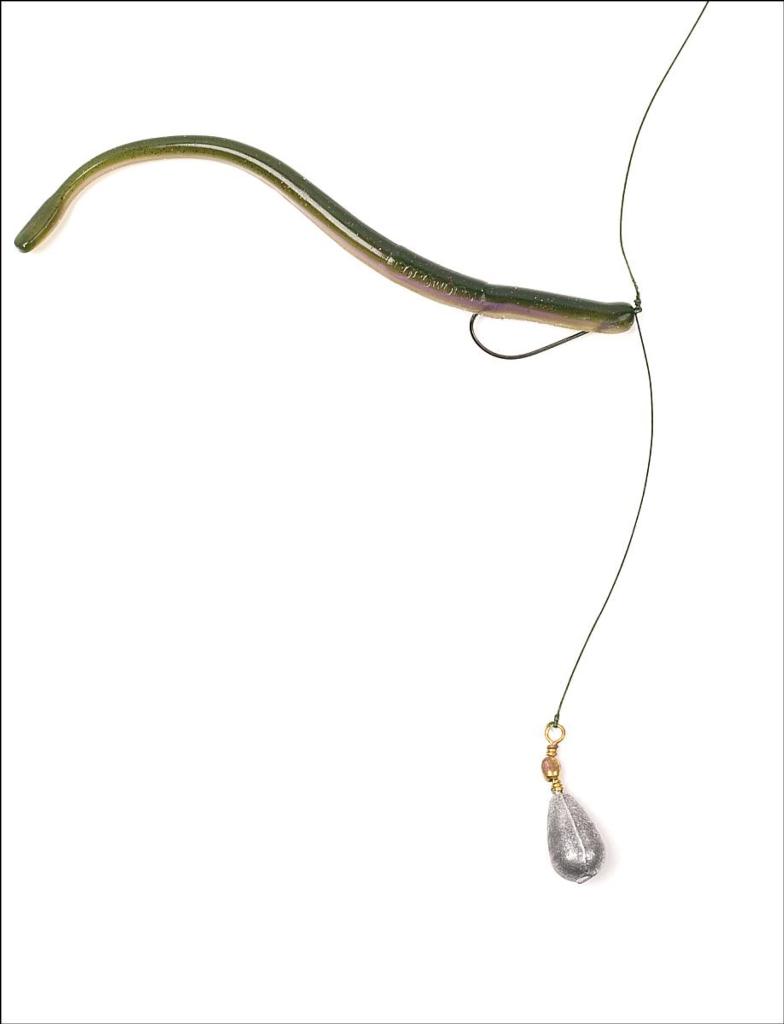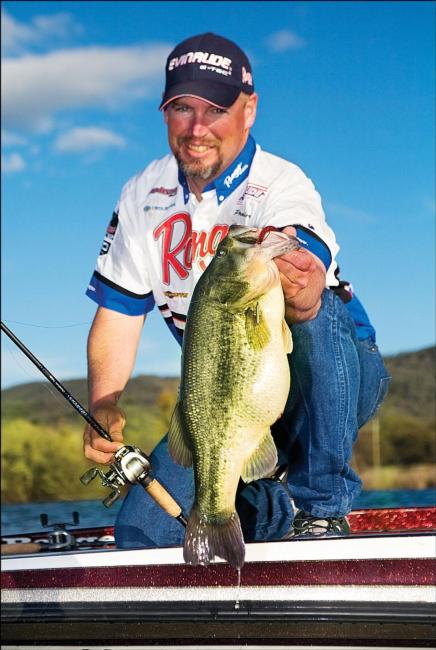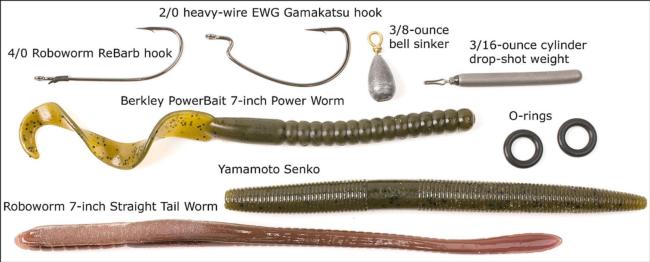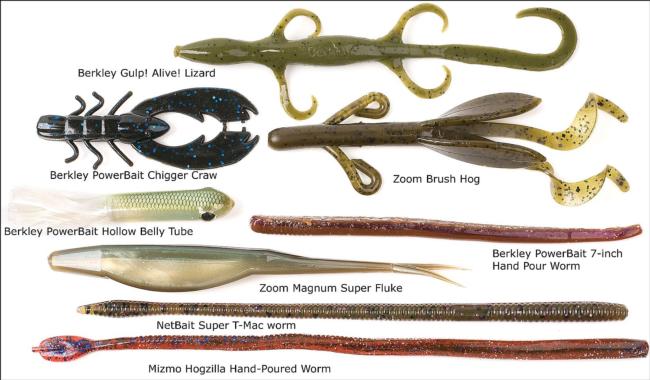The flip-shot
Fish softly but still carry your big stick

————————————–
Editor’s note: Learn more about FLW Outdoors Magazine and how to subscribe by clicking here.
————————————–
The worm and weight spiraled end over end between the tules like a South American bola on its way to snare wild game. The rapid pitch-and-twirl combo hit the water with a near-silent entry, and the dark corner of the reed clump was motionless. Professional angler Michael Rooke of Lake Havasu City, Ariz., stood statuesque, peering into the water for what seemed like an eternity. Slowly, he raised the tip of his rod.
Whip! The line snapped taut as the water erupted into a frenzied froth. The rod flexed rapidly under the weight of the thrashing bass. But he worked it quickly to the side of the boat, and in one nearly falling motion, he hit the deck and netted the bass. It was the catch of a lifetime. Not his biggest bass, but certainly the largest he’d ever caught in competition. But the fact that he caught it on the final day of the Walmart FLW Series National Guard Western Division event on the California Delta in 2007 made it his most rewarding – to the tune of $100,000.
What was his amazing bait? A drop-shot. Most people immediately wonder how he landed an 11-pound, 10-ounce bass on a spinning rod with 6-pound line. Well, he didn’t, as a matter of fact. He landed that bass on 15-pound fluorocarbon line and a baitcaster with a heavy-action flipping stick. Yes, he was flipping a drop-shot – the “flip-shot,” if you will.
Rooke’s take
Rooke isn’t the first angler to throw a drop-shot at shallow fish, but he has certainly learned how effective the technique can be.
“I got started throwing this bait out of necessity,” Rooke said. “I was losing too many big fish at places like the California Delta and Lake Amistad. The finesse worm on a drop-shot was getting the bites, but I couldn’t land any of them. Heavy cover calls for heavy tackle.”
He started fishing the drop-shot shallow after he saw how many fish were being caught on Yamamoto Senkos and other soft, weightless plastics. Anglers were proving that a quiet, finesse approach up shallow worked. So there was no reason a drop-shot wouldn’t produce.
“It gives the worm a different presentation,” Rooke said. “When bass are pressured by anglers or the weather, it’s a lure you can leave right in their faces up off the bottom and provoke them into biting.”
Rooke likes the flip-shot around all sorts of shallow cover, from grass beds, tules and brush piles to rock piles, docks and riprap, although it can be snaggy around brush piles if the dropper to the weight is too long. Thus, one key component to tying the rig is keeping the leader between the hook and the bell sinker short. Four to 6 inches is plenty.
Other than length, rigging doesn’t require much in the way of special attention. Rooke ties a Palomar knot to a 4/0 Roboworm ReBarb hook and feeds his tag end back through the eye so the hook stands out perpendicular to the line with the hook point above the shank. At the end of the dropper, Rooke ties on the lightest weight he can get by with under the given conditions.
A quick-pinch keeper is likely to pull off a drop-shot in heavy cover, but a standard bell sinker tied directly to the line makes a much stronger weight system. In most cases, a 1/4-ounce weight works well, but if the wind and wave action really get up, Rooke sometimes goes to a 3/8-ounce bell sinker.
He will also upsize to 30- or 40-pound braided line if he’s fishing really dense tules or brush. The heavier cover requires heavier line, and the braid doesn’t inhibit his presentation in a tangled mess of  wood and grass.
wood and grass.
For the important part of the rig, the pro primarily sticks to a couple of types of worms. He likes the oxblood Roboworm 6- and 7-inch Straight Tail worms and green pumpkin Berkley PowerBait 7-inch Power Worms. Both colors work in clear or stained waters.
Strader’s strengths
No stranger to power fishing, pro Phil Strader of Glide, Ore., is well known in West Coast events for being a power fisherman. He likes to flip and pitch and throw big swimbaits for bruiser largemouths but has added the flip-shot to his arsenal in recent years. He echoed a lot of what Rooke said, even though he arrived at many of the same conclusions via different routes.
“The drop-shot has proven very effective in catching pressured or finicky fish that are affected by heavy weather changes or fishing pressure,” Strader said. “But I’ve never been a fan of fishing light-line or finesse applications, and I probably overlooked its effectiveness around heavy cover for a while because of that.”
Many anglers assume a drop-shot requires light line, and once Strader realized it had heavy-tackle implications, he started boating some big bass with smaller worms and thick line in heavy cover.
“It depends on water clarity,” Strader said. “If the water is real clear, I’ll go with heavy 14- to 16-pound fluorocarbon. If the cover is real dense or the water is stained I’ll go straight to braid. It doesn’t matter what cover is shallow. It can be dock pilings, bridge pilings, tules, grass beds, standing timber or brush piles. I even catch them up against retaining walls in the spring on this rig.”
Strader favors a 3/16-ounce cylinder drop-shot weight because he feels that shape snags less in dense cover. Start with the lightest weight possible and work up from there, depending on water depth and wind, although sometimes Strader goes as heavy as 1/2 ounce if it’s really windy. The heavier weight also helps to fish very fast and cover water, using frequent pitches and moving the rig quickly along without losing contact with the bottom.
Like Rooke, Strader keeps his leader short at 2 to 6 inches. And he prefers a 1/0 or 2/0 heavy-wire EWG Gamakatsu hook.
“This is not a presentation for nose-hooking little worms,” Strader said. “I like to Texas-rig it or Tex-pose the worm so the point lies on the back of the worm and just the tip of the point is in the plastic. That keeps me out of the cover but still makes it easy to get a good hookup with a big bass.”
The weather and fish dictate how fast to fish and how much action to impart on the worm. If a front moves through the area, Strader generally slows way down and saturates key spots with the flip-shot.
Pitch the bait to an opening or piece of cover and let it sit there for six to eight seconds before moving the bait. Tighten up the line very slowly, and a lot of the time, a fish will already have the worm. If not, shake the line and let the worm sit on semislack line.
“I never want to be tightened up on the bait,” Strader said, “but I also don’t want it sitting on the bottom.”
After three or four shakes, pitch to the next spot. If he’s really trying to work out from the cover, like on days when the sky is cloudy and fish are roaming and a little more active, Strader pulls the weight then shakes it, then pulls it a little more and shakes it. He always concentrates on working the line and not the weight. If he feels like he’s popping the weight, he’ll back off on his shakes, which should be very subtle movements – just enough to make the worm undulate in the water.
Strader also keeps his worm selection simple. He fishes Roboworms almost exclusively on his flip-shot, preferring the fat-bodied, 6-inch variety. In dark water, he’ll stick with greens and browns, and in clear water he likes the shiner and shad patterns. More important, though, is location and action than specific detail-oriented colors, so the pro focuses instead on general hues.
One other option is a Yamamoto Senko rigged wacky-style with two O-rings around the worm, crisscrossed over the hook to hold everything in place and keep the stick bait together. Again, Strader will stick to subtle movements. Slow lifts and drops let the bait work its magic in the strike zone for longer periods of time than more conventional presentations.
Both anglers have taken some real giants on the setup and have proven its effectiveness in tournament situations on a wide variety of fisheries. Should it replace every angler’s Texas-rigged or weightless-rigged shallow presentation? Of course not. But it’s an effective way to present a worm or other soft bait that the fish don’t see as often and, thus, are less conditioned to ignore. And the result often is more and bigger bass where other presentations have failed.
In the ever-changing game of fishing, the flip-shot will add a little variety to an otherwise shunned shallow-water presentation. (Editor’s note: Sidebar article located below graphic underneath.)

Going big on flip-shot baits
Just like thinking a drop-shot can only be used deep in clear water with light line, many anglers won’t put anything longer than 4 inches on a drop-shot hook. Again, it’s merely another means to present a soft bait. Several other alternatives exist for anglers wanting to get a certain profile in front of finicky fish.
This summer, I experimented with big worms on a drop-shot and had surprising success. I caught a lot of fish on a NetBait Super T-Mac worm. I think a Mizmo Hogzilla Hand-Poured Worm and especially the new Berkley PowerBait 7-inch Hand Pour Worm will be dynamite flip-shot baits. Those big worms seemed to entice sizable bass from shallow stumps – obvious targets that had certainly been fished already. The key is presenting them in a manner the fish haven’t seen already.
Another type of bait that can be effective on a flip-shot rig is a creature- or craw-type lure. Something like a Zoom Brush Hog or a Berkley PowerBait Chigger Craw offers the bass a totally different look – especially on a fishery with large bass that have seen a lot of straight-worm presentations. Mixing it up with a bulky profile often spells success when the bass are conditioned to slimmer profiles or if they’re actively feeding on big-profile baits like crayfish and sunfish.
The point of the exercise is to challenge anglers to be more creative with their offerings. If the flip-shot is a different way to present a lure, then putting a large-sized soft plastic or other bait on the hook might open up new possibilities. Experiment with shapes like Zoom Magnum Super Flukes, Berkley PowerBait Hollow Belly tubes and swimbaits to give the fish something more. A Berkley Gulp Alive Lizard could be a deadly offering for bass in the spring on a flip-shot.
Keep in mind it’s important to match the hook to the size of the lure. When using magnum baits, be sure to use a hook large enough to clear the body of the bait on the hookset to get good penetration.
Hopefully from this extension anglers will open up a whole new realm of possibilities for shallow soft baits.
